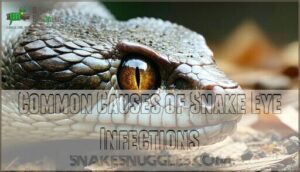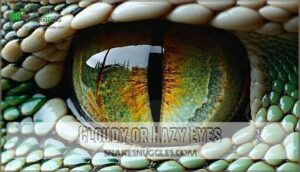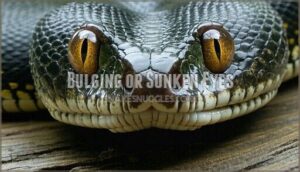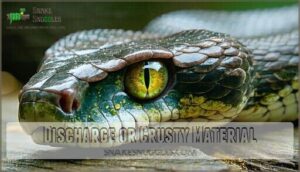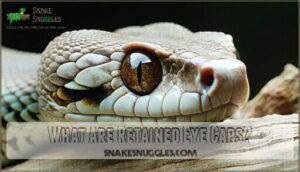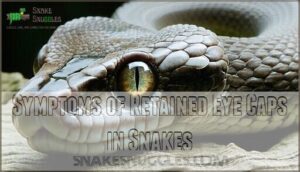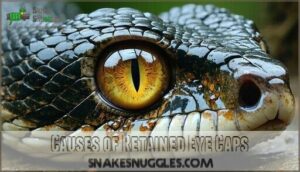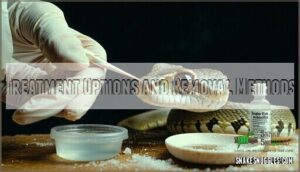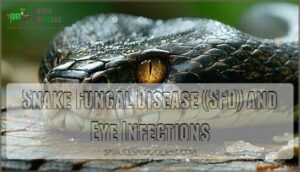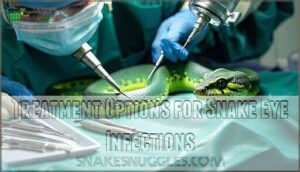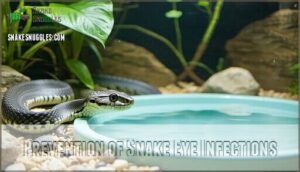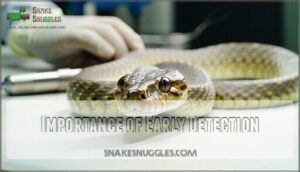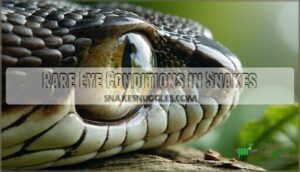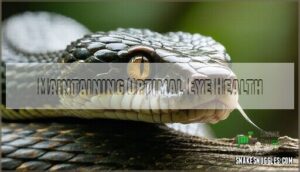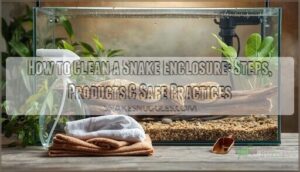This site is supported by our readers. We may earn a commission, at no cost to you, if you purchase through links.
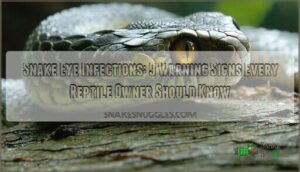
These infections, often caused by bacteria or fungi, can lead to painful abscesses, and you’ll want to watch for signs like cloudy eyes, discharge, or bulging.
Retained eye caps, a common issue, can also lead to infections, and by understanding the causes and symptoms of snake eye infections, you can take proactive steps to protect your pet’s vision.
We’re about to explore some key warning signs and prevention strategies that can make all the difference.
Table Of Contents
- Key Takeaways
- Common Causes of Snake Eye Infections
- Symptoms of Eye Issues in Snakes
- Understanding Retained Eye Caps
- Snake Fungal Disease (SFD) and Eye Infections
- Diagnosing Snake Eye Infections
- Treatment Options for Snake Eye Infections
- Prevention of Snake Eye Infections
- Importance of Early Detection
- Rare Eye Conditions in Snakes
- Maintaining Optimal Eye Health
- Frequently Asked Questions (FAQs)
- How to treat a snake eye infection?
- Do snake eyes ever heal?
- How do you treat snake venom in the eyes?
- Can Snakes get eye infections?
- Can a snake have a conjunctivitis?
- What is snake fungal disease?
- What is ophidiomycosis snake fungal disease?
- Can snakes get eye infections?
- How to treat eye infection in reptiles?
- What is wrong with my snakes eye?
- Conclusion
Key Takeaways
- You’ll want to recognize the signs of snake eye infections, such as cloudy eyes, discharge, or swelling, to get your pet the right treatment and prevent long-term damage.
- Maintaining a clean and healthy environment is crucial to preventing snake eye infections, so you’ll need to focus on proper humidity and temperature control, regular cleaning and disinfection, and minimizing stress and handling.
- Regular veterinary check-ups are essential to detecting snake eye infections early, and you’ll want to work with a vet to determine the best treatment options, which may include antibiotics, antifungals, or surgery.
- By taking proactive steps, such as providing proper care and attention, you can help prevent snake eye infections and ensure your pet’s overall well-being, so it’s key to stay vigilant and keep your snake’s vision sharp.
Common Causes of Snake Eye Infections
You’ll find that most snake eye infections stem from poor husbandry conditions, including improper humidity levels, unsanitary environments, or nutritional deficiencies.
Proper care is key to preventing snake eye infections and promoting overall health.
Bacterial pathogens like Pseudomonas, parasites such as mites, physical trauma, and retained eye caps can all compromise your snake’s eye health and require prompt attention.
Dehydration and Malnutrition
Without proper hydration and nutrition, your snake’s eyes become vulnerable to infections.
Dehydration and malnutrition weaken the immune system, making your reptile susceptible to eye problems. Vitamin A deficiency specifically impacts eye health in snakes.
Three critical actions to prevent issues:
- Maintain a water bowl large enough for soaking
- Provide species-appropriate diet with correct nutrients
- Monitor humidity levels in the enclosure
Poor husbandry practices compound these risks, so maintaining proper hydration and nutrition isn’t just good care—it’s essential protection against painful snake eye infections.
Mites and Fungal Infections
Tiny mites and insidious fungal infections are among the most common culprits behind snake eye problems.
The Ophidiomyces ophiodiicola fungus can cause Snake Fungal Disease (SFD), leading to cloudy eyes and skin lesions. Meanwhile, mites burrow near eye edges, causing irritation and secondary infections.
For effective treatment, you’ll need specialized antifungals and thorough environmental control. Mite identification is essential – look for tiny moving specks near your snake’s eyes and scales.
To prevent re-infestation, maintain proper humidity levels and quarantine new reptiles before introducing them to your collection. Regular terrarium cleaning disrupts fungal transmission cycles.
Bacterial Infections and Parasites
While fungi and mites can cause trouble, bacterial invaders and parasites pose equally serious threats to your snake’s eyes.
Pseudomonas aeruginosa and Aeromonas infections often enter through tiny scratches, causing redness and discharge. Meanwhile, parasitic hitchhikers create their own problems.
- Chlamydophila bacteria thrive in unsanitary conditions
- Mite infestations often concentrate around eye scales
- Tick removal requires careful technique to avoid eye damage
Regular cleaning and inspection will help keep these microscopic troublemakers at bay.
Eye Trauma and Physical Harm
While bacterial and parasitic infections pose serious threats, physical trauma is equally concerning for your snake’s delicate eyes.
Physical damage often occurs when snakes encounter rough environments or dangerous situations. Here’s what you need to watch for:
| Cause | Result | Prevention |
|---|---|---|
| Cage Abrasions | Scratched spectacles | Smooth enclosure surfaces |
| Prey Injuries | Bite wounds | Proper feeding techniques |
| Foreign Objects | Eye irritation | Regular habitat inspection |
Snakes rubbing against abrasive surfaces can damage their protective eye scales, while aggressive prey might cause bite wounds. Always check your enclosure for sharp edges that could harm your slithery friend. Ensure you practice proper feeding techniques to prevent injuries.
Symptoms of Eye Issues in Snakes
You’ll need to watch for specific changes in your snake’s eyes that signal potential problems, including cloudiness, swelling, discharge, or retained eye caps.
Early detection of these symptoms can mean the difference between simple treatment and serious complications, so check your pet’s eyes regularly during your routine care to ensure early detection.
Cloudy or Hazy Eyes
When your snake’s eyes look cloudy or hazy, it’s often a warning sign of potential health issues.
Here are 4 causes to watch for:
- Dehydration Signs causing spectacle opacity
- Subspectacular Fluid buildup from blocked ducts
- Diet Impact affecting eye health and clarity
- Vision Impairment from retained shed
Don’t ignore cloudy snake eyes—they’re rarely normal outside shedding periods and often indicate infection or husbandry problems.
Bulging or Sunken Eyes
While cloudy eyes might signal early problems, altered eye shape often indicates more serious issues.
When your snake’s eyes appear bulging or sunken, it’s time to take action. These changes often point to critical health problems that need addressing quickly.
| Eye Condition | Possible Cause | Severity | Action Needed | Timeline |
|---|---|---|---|---|
| Bulging (Exophthalmia) | Spectacle pressure, infection | Moderate-High | Vet visit | 24-48 hours |
| Sunken (Enophthalmia) | Severe dehydration | High | Immediate hydration | ASAP |
| Uneven bulging | Abscess or injury | High | Veterinary care | Same day |
| One eye affected | Localized infection | Moderate | Vet consultation | 1-3 days |
| Both eyes affected | Systemic illness, fluid imbalance | High | Emergency vet care | Immediately |
Remember that hydration status and nutritional deficiencies often contribute to eye shape changes. Underlying diseases may first manifest through eye abnormalities, so don’t wait, as immediate action is crucial for your snake’s health, especially in cases of severe dehydration or critical health problems.
Discharge or Crusty Material
While bulging or sunken eyes signal problems, eye discharge or crusty material is equally concerning.
These symptoms often reveal underlying infections that need prompt attention.
Watch for these warning signs:
- Yellow-green discharge with thick consistency
- White or brownish crust forming around eye rims
- Clear, watery secretions that persist for days
- Colored residue that changes the spectacle appearance
Treatment urgency increases with discharge severity.
Bacterial infections typically produce more concerning secretions than mild irritations.
Don’t wait if you notice eye discharge or crusty material—veterinary care should be your immediate next step.
Regular cleaning prevents these issues from developing.
Incomplete Shedding and Retained Eye Caps
Your snake’s incomplete shedding and retained eye caps are warning signs you shouldn’t ignore. These transparent scales can become stuck during dysecdysis (problematic shedding), causing discomfort and vision impairment.
Watch for cloudy spectacles that don’t clear after shedding or empty eye holes in shed skin.
Never attempt to remove retained caps yourself—improper technique can damage the eye, and it’s crucial to ensure proper humidity levels and sufficient hydration for your snake’s health. Additionally, providing shedding aids can help prevent issues like retained eye caps.
Behavioral Changes and Discomfort
While your snake’s cloudy eye caps are concerning, behavioral changes often tell the bigger story.
Watch for appetite loss, unusual aggression, excessive hiding, and frequent eye rubbing—classic signs of eye discomfort.
Your normally active snake becoming lethargic or suddenly squinting should prompt immediate attention.
These behavioral shifts aren’t just mood swings; they’re your reptile’s way of communicating that something’s wrong with their eyes.
Understanding Retained Eye Caps
You’ll notice your snake’s retained eye caps as cloudy layers that don’t shed with the rest of its skin, creating a potential gateway for infections if left untreated.
These transparent shields, which normally protect your reptile’s eyes, can cause serious problems when they accumulate, making prompt identification and proper humidity management essential for your scaly friend’s vision and comfort.
What Are Retained Eye Caps?
Unlike normal eyelids, snakes have transparent scales called "spectacles" covering their eyes.
Retained eye caps occur when these spectacles don’t shed properly during dysecdysis.
These protective layers should detach with the rest of the skin during shedding, but sometimes they’ll stick, creating a cloudy appearance.
Without treatment, retained eye caps can lead to vision impairment, infections, and discomfort for your pet.
Proper humidity levels are essential for prevention.
Symptoms of Retained Eye Caps in Snakes
You’re on the lookout for signs of retained eye caps in your snake.
Check for empty eye holes in shed skin or a grey, foggy eye appearance. Cloudy eyes, eye discharge, or rubbing behavior can indicate issues.
Retained eye caps can cause milky eyes, vision impairment, and swollen spectacles, often due to shedding difficulty or dysecdysis.
Low humidity can be a factor, so increase enclosure humidity to help them shed.
Causes of Retained Eye Caps
You’re dealing with retained eye caps, likely due to low humidity, improper shedding, or poor health.
Causes include:
- Dehydration
- Malnutrition
- Parasites
- Mites
- Bacterial infections, which can lead to snake eye infections and shedding problems, emphasizing the need for proper humidity levels and snake eye care.
Treatment Options and Removal Methods
You’re dealing with a retained eye cap in your snake.
Gentle soaking in warm water may help. If not, veterinary care is best.
They may suggest surgical removal or topical antibiotics, along with fluid flushing and corneal repair, ensuring proper snake eye treatment with vitamin supplementation.
Some owners also seek snake eye antibiotics for treatment.
Prognosis for a Snake With Retained Eye Caps
You can help your snake recover from retained eye caps with prompt treatment, reducing vision impairment and infection risk.
Proper humidity levels and shedding frequency are key to treatment success and a positive long-term outlook, preventing snake shedding problems and snake eye infections.
Snake Fungal Disease (SFD) and Eye Infections
You’ll want to recognize the signs of Snake Fungal Disease (SFD) and eye infections in your snake, as they can be serious and even life-threatening.
By understanding the causes, symptoms, and treatment options for SFD and eye infections, you can take steps to protect your snake’s health and prevent long-term damage.
Causes and Transmission of SFD
You’re managing your snake’s environment to prevent fungal infections, specifically Snake Fungal Disease (SFD), caused by Ophidiomyces ophiodiicola, which spreads through snake-to-snake contact or contaminated surfaces, thrives in humid conditions, and affects species susceptibility.
The disease is characterized by skin lesions and nodules, impacting snake populations across North America, making environmental factors key to preventing SFD and snake eye infections.
Symptoms and Clinical Signs of SFD
You’ll notice skin lesions or shedding difficulties if your snake has SFD, a fungal disease caused by Ophidiomyces ophiodiicola.
Leading to corneal abnormalities, vision impairment, and behavioral changes, including cloudy eyes and lesion progression, common snake eye symptoms of snake fungal disease.
Your snake will exhibit these symptoms, including cloudy eyes, as a result of the disease.
Diagnosis and Treatment of SFD
For an SFD diagnosis, your vet might use fungal cultures or DNA tests. Accurate snake eye diagnosis is key!
Once identified, treatment often means antifungals like itraconazole.
Here’s what to expect:
- Antifungal Treatments: Topical or injected antifungals.
- Supportive Therapy: Boost their immune system.
- Surgical Intervention: Only if needed.
SFD research helps us understand snake eye infections SFD. Prognosis factors depend on how early you catch it, which is why early detection is crucial.
Prevention and Management of SFD
After grasping SFD diagnosis, let’s explore prevention and management. You can manage snake fungal disease SFD with early action.
Boost public awareness about Ophidiomyces ophiodiicola. Habitat management is key; keep it clean. Antifungals are treatment options, but watch for antifungal resistance.
Research snake health and share experiences.
:
—————–
:
———————————–
Diagnosing Snake Eye Infections
You’ll need to identify the signs of snake eye infections to get your pet the right treatment.
By recognizing the symptoms and using diagnostic techniques like visual exams and lab tests, you can help your veterinarian determine the best course of action for your snake’s eye health.
Visual Examination Techniques
You’ll use visual examination techniques to diagnose snake eye infections.
These include:
- Eyelid Inspection
- Pupil Dilation
- Ocular Discharge check
- Corneal Staining to detect issues, helping you identify eye cloudiness, bulging, or sunken eyes.
Regular shedding patterns indicate good health, so any abnormalities should be noted, and a snake health checklist can help monitor your snake.
Laboratory Testing Methods
You’ll use laboratory testing, including blood work, culture testing, and microscopy, to diagnose snake eye infections.
PCR diagnostics and DNA analysis help identify bacteria and fungus, guiding antibiotic treatment and ensuring your snake receives proper care.
Veterinarians also use imaging studies for internal evaluation, which is a crucial part of providing proper care.
Histopathological Examination of Eye Tissue
You examine tissue samples to identify tissue abnormalities and infections.
- Infection identification
- Cellular analysis
- Diagnostic insights
- Research applications
help your snake eye vet diagnose snake eye diseases and ophthalmic diseases, including snake eye histopathology and snake eye infections.
PCR and DNA-based Diagnostics
You’ll use PCR specificity and DNA sequencing for genetic identification of pathogens.
| Method | Description |
|---|---|
| PCR | Detects DNA |
| DNA Sequencing | Identifies mutations |
Snake eye infections, like bacterial or fungal ones, are diagnosed using these methods, including Pseudomonas aeruginosa detection, for genetic identification of pathogens.
Treatment Options for Snake Eye Infections
You’ll need to work with a veterinarian to determine the best treatment for your snake’s eye infection, which may include antibiotics, antifungal medications, or surgery.
By understanding the various treatment options, you can help your snake recover from an eye infection and prevent future problems, using methods that may include surgery.
Antibiotics and Antifungal Medications
When treating snake eye infections, consider antibiotics and antifungals like ciprofloxacin or Terramycin ophthalmic ointment.
Balancing effectiveness with potential medication side-effects and antibiotic resistance, is crucial to guarantee the best outcome for your pet.
Eye Drops and Topical Treatments
You’re looking for ways to treat your snake’s eye infection. Eye drops or topical treatments can help.
Your vet may recommend antibiotic or antifungal applications. You can find various snake eye drops online.
- Follow dosage guidelines
- Use reptile-safe eye rinse
- Apply Terramycin ophthalmic ointment
- Monitor for resistance development
Surgical Procedures and Hospitalization
Considering snake eye surgery? Choosing the right vet minimizes anesthesia risks.
Hospitalization costs add up, but proper post-op care guarantees smoother recovery, managing recovery time effectively for snake eye infections and surgery.
Sedation is often preferred, as it can greatly reduce stress and discomfort to ensure a more comfortable procedure.
Supportive Care and Recovery
You play a key role in your snake’s recovery.
Provide nutritional support and hydration therapy to boost healing time.
Utilize wound management and stress reduction techniques, like environment enrichment, to aid snake eye recovery, and follow vet advice on snake eye medication, such as topical antibiotics.
Prevention of Snake Eye Infections
You can prevent snake eye infections by maintaining a clean and healthy environment for your pet.
By following proper care and hygiene practices, such as regular cleaning and disinfection, you can reduce the risk of eye infections and keep your snake healthy.
Proper Humidity and Temperature Control
Success in snake care hinges on proper temperature gradients and humidity monitoring. You’ve got to get it right!
Too much humidity levels? Hello, bacteria and eye infections! Good ventilation is your friend.
- Consistent Thermostat Calibration
- Environmental Enrichment boosts immunity
- Shedding Success depends on humidity
Keep your snake habitat clean. Remember, snake eye medication isn’t the goal. Dial in those environmental factors within the snake enclosure, and your snake will thank you for a successful snake care experience.
Regular Cleaning and Disinfection
You’re taking the right step to prevent snake eye infections by focusing on regular cleaning and disinfection.
Clean your snake’s terrarium frequently, sanitizing the substrate and water bowl to prevent bacterial growth. Use safe products for Terrarium Disinfection and Substrate Sanitation.
Proper Water Bowl Hygiene is also key. Aim for a Cleaning Frequency that keeps the enclosure clean and your snake healthy, reducing the risk of snake eye infections through good disinfection and enclosure cleaning practices, including snake eye cleaning and snake hygiene.
Maintaining a healthy environment requires using reptile-safe cleaning products.
Minimizing Stress and Handling
Making your snake feel safe involves stress-free handling. Think of it as a dance.
- Gentle handling reduces snake eye infections.
- Recognize stress to avoid environmental stressors.
- Handling tools improve snake hygiene.
Gentle handling and proper enclosure design help. Snakes appreciate their space. By understanding snake behavior, you can reduce stress.
Reduce frequency and use a secure grip. Handling precautions bolster their immune system. This minimizes risks of snake eye infections. Remember, a happy snake is a healthy snake.
Regular Veterinary Check-ups
You’ll want regular vet checkups for preventative care.
This includes:
- Physical exams
- Health assessments
- Early detection of eye infections
- Husbandry guidance from a reptile vet, ensuring expert advice for health monitoring and regular screening.
The goal is to ensure expert advice for health monitoring and regular screening through these checkups.
Importance of Early Detection
You play a vital role in detecting snake eye infections early, as it can substantially impact your pet’s vision and behavior.
By recognizing the warning signs and taking prompt action, you can prevent long-term effects and improve your snake’s prognosis and survival rates.
Impact on Snake Vision and Behavior
You’ll notice snake vision problems and behavioral changes if eye infections occur.
Vision impairment affects hunting, leading to stress indicators like cloudy eyes.
Snakes may adapt, but blindness can result, emphasizing the need to address eye problems promptly to prevent long-term sensory compensation and related issues, which can lead to stress indicators.
Prevention of Long-term Effects
To prevent long-term issues from snake eye infections, catch those early signs! Cloudy eyes or odd behavior? Act fast!
- Vision Preservation
- Scarring Prevention
- Infection Control
- Behavioral Impacts
Quick vet visits and good Preventative Husbandry are essential. Think proper diet and hydration. It’s like being a snake detective. Your watchful eye prevents issues like blindness, scarring, or corneal ulcers. Practice preventive care!
Improved Prognosis and Survival Rates
You boost your snake’s prognosis with early intervention, using antibiotics and advanced treatments.
| Treatment | Effectiveness | Cost |
|---|---|---|
| Itraconazole | High | Medium |
| Voriconazole | High | High |
| Antibiotics | Medium | Low |
| Veterinary Care | High | Medium |
| Proactive Care | High | Low |
Rare Eye Conditions in Snakes
You’ll want to be aware of rare eye conditions in snakes, such as cataracts and glaucoma, that can affect your pet’s vision.
By recognizing these conditions, you can take action to prevent or treat them, ensuring your snake’s eye health and overall well-being.
Cataracts and Glaucoma
Early detection is key to your snake’s health. Let’s explore rare snake eye conditions.
Cataracts and glaucoma can impact your snake’s vision. These conditions affect vision clarity and eye pressure.
- Causes: Aging, genetic factors, underlying diseases.
- Symptoms: Cloudy eyes, vision loss, unusual movement.
- Treatment: Snake vet visits, eye drops, or cataract surgery.
- Prevention: Regular check-ups and pressure management.
If you notice anything, seek help. Don’t let snake eye blindness happen, as early detection is crucial for your snake’s health, and regular check-ups can prevent severe conditions.
Conjunctivitis and Uveitis
You’re now dealing with conjunctivitis and uveitis, rare but serious snake eye infections.
Conjunctivitis causes redness and swelling, while uveitis leads to pain and vision loss.
Diagnosis methods and treatment options are available, including eye drops and medication, to tackle these reptile eye infections and prevent future issues, particularly with uveitis.
Mites and Ticks in Snakes
You’ll want to spot those pesky mites and ticks in your snake to prevent snake eye infections.
- Regularly clean the enclosure
- Check for infestation signs
- Maintain proper humidity
Provide veterinary care to address mites and ticks, and prevent parasites, which can cause snake eye infections, through accurate mite identification and effective tick prevention, and explore treatment options.
Congenital Malformations and Anomalies
You’ll encounter congenital malformations, like microphthalmia, due to genetic predisposition or teratogenic exposure during embryonic development.
Breeding practices can impact these rare deformities, including snake eye anomalies and congenital ocular malformations, which can lead to snake eye infections and other issues.
Maintaining Optimal Eye Health
You play a vital role in maintaining your snake’s best eye health by providing proper care and attention.
By following simple tips, such as regular eye checks and proper hygiene, you can help prevent eye infections and guarantee your snake’s overall well-being.
Regular Eye Checks and Exams
You play a significant role in maintaining your snake’s eye health.
Regular eye checks are essential to catch snake eye infections early.
Consult a veterinarian with reptile expertise for frequency guidelines on examination techniques.
Recognizing abnormalities at home can also help with early detection.
By combining home exams with vet expertise, you’ll be better equipped to provide proper eye care and prevent issues.
Regular veterinary care is key to keeping your snake’s eyes healthy, so don’t hesitate to seek advice on maintaining ideal snake eye health and detecting potential problems promptly.
This helps prevent severe infections and is crucial for the overall health of your snake, emphasizing the importance of regular eye checks, proper eye care, and early detection to ensure your snake remains healthy.
Proper Eye Care and Hy
You’re looking to keep your snake’s eyes healthy.
To do so, consider:
- Maintaining proper humidity levels
- Cleaning the enclosure regularly
- Handling your snake safely.
This will help prevent snake eye infections and promote overall snake eye health through good hygiene and care.
Frequently Asked Questions (FAQs)
How to treat a snake eye infection?
Carefully clean the eye with reptile-safe solutions, apply topical antibiotics as prescribed, and maintain proper hygiene to treat the infection effectively.
Do snake eyes ever heal?
You’ll be relieved to know that, yes, snake eyes can heal with proper treatment, care, and attention to their specific needs and environment.
How do you treat snake venom in the eyes?
You’ll need to flush your eyes with water, then seek medical attention immediately if snake venom gets in them, as it can cause severe damage or blindness.
Can Snakes get eye infections?
You can help prevent eye issues in snakes by maintaining proper humidity, cleaning their enclosure, and providing a balanced diet to reduce the risk of eye infections.
Can a snake have a conjunctivitis?
You can diagnose conjunctivitis in snakes through symptoms like discharge, redness, and swelling, requiring veterinary care for proper treatment and prevention of further complications.
What is snake fungal disease?
You’ll find Snake Fungal Disease, or SFD, is a condition caused by the fungus Ophidiomyces ophiodiicola, affecting snakes’ skin, eyes, and overall health, requiring prompt veterinary attention and treatment.
What is ophidiomycosis snake fungal disease?
You’re dealing with ophidiomycosis, a fungal disease affecting snakes, caused by Ophidiomyces ophiodiicola, leading to skin lesions, blisters, and other issues, so proper treatment from a veterinarian is necessary.
Can snakes get eye infections?
You can spot eye infections in snakes through cloudy eyes, discharge, or swelling, which can be caused by bacteria, fungi, or parasites, so monitor their eyes closely for any signs.
How to treat eye infection in reptiles?
An ounce of prevention is worth a pound of cure." You’ll treat eye infections in reptiles with antibiotics, antifungals, and proper hygiene, under a vet’s guidance, of course.
What is wrong with my snakes eye?
You should inspect your snake’s eye for signs of infection, such as cloudiness, discharge, or swelling, and consult a veterinarian for proper diagnosis and treatment if you notice any issues.
Conclusion
Freshly faced with the facts, you’re now better equipped to fight snake eye infections.
By recognizing the 9 warning signs, you’ll protect your pet from painful problems.
Remember, prompt action prevents long-term damage from snake eye infections, so stay vigilant and keep your snake’s vision sharp.
- https://www.cdc.gov/pseudomonas-aeruginosa/about/index.html
- https://cwhl.vet.cornell.edu/disease/snake-fungal-disease
- https://www.floridamuseum.ufl.edu/florida-snake-id/snake/brahminy-blindsnake/
- https://www.ncbi.nlm.nih.gov/pmc/articles/PMC4245397/
- https://www.researchgate.net/publication/12546386_Diagnostic_ophthalmology_Bullous_spectaculopathy_in_a_king_snake

